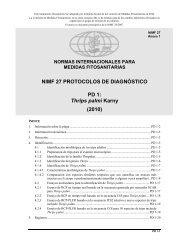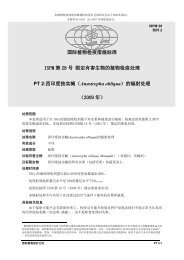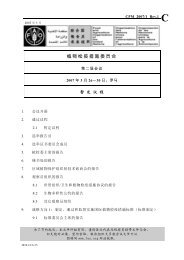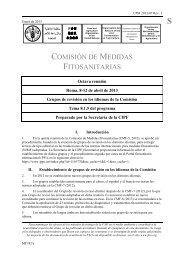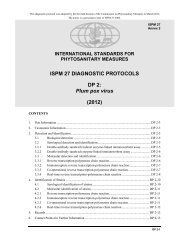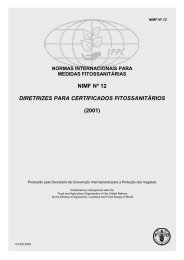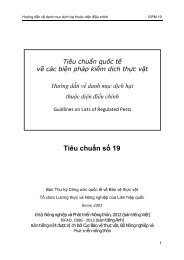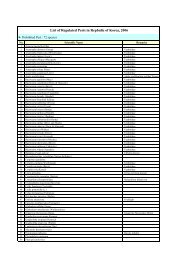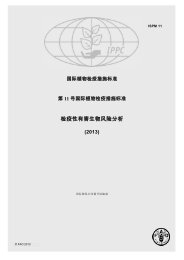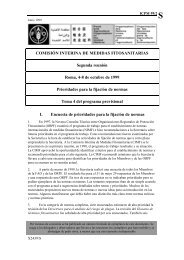Untitled
Untitled
Untitled
You also want an ePaper? Increase the reach of your titles
YUMPU automatically turns print PDFs into web optimized ePapers that Google loves.
3.4.11 Country IPP Report: Cambodia<br />
1. Responsibilities of the National Plant Protection Organization (NPPO)<br />
Responsibilities of the National Plant Protection Organization Under the<br />
WTO/SPS Agreement<br />
Under the WTO/SPS Agreement, the Secretariat of the International Plant Protection<br />
Convention (IPPC) has been designated as the international technical agency for<br />
coordinating and developing international standards for phytosanitary measures. The<br />
scope and responsibilities of the NPPO are extensive and cover a range of activities.<br />
The main responsibilities of the NPPO as specified in the IPPC, 1997, and the SPS<br />
Agreement are as follows:<br />
- Take effective action to prevent the spread and introduction of pests of plants and<br />
plant products and promote appropriate measures for their control (IPPC, Article I,<br />
point 1)<br />
- Issuance of phytosanitary certificates (Article IV, point 2a); surveillance of growing<br />
plants (IPPC, Article IV, point 2b);<br />
- The inspection of consignments (IPPC, Article IV, point 2b);<br />
- Disinfestations and disinfection of consignments moving in international traffic<br />
(IPPC, Article IV, point 2c);<br />
- The protection of (pest) endangered areas (IPPC, Article IV, point 2e)<br />
- Conduct of pest risk analysis (to justify phytosanitary measures) (IPPC, Article IV,<br />
point 2f)<br />
- Ensure phytosanitary security of consignments (IPPC, Article IV, point 2g)<br />
- Training and development of staff (IPPC, Article IV, point 2h);<br />
- Distribution of information within the country regarding regulated pests (IPPC,<br />
Article IV, point 3a); research and investigation in plant protection (IPPC, Article IV,<br />
point 3 b)<br />
- Issuance of phytosanitary regulations (Article IV; point 3c)<br />
- Publish and transmit phytosanitary requirements to trading partners [IPPC, Article<br />
VII, point 3 b]<br />
- Provide rationale for phytosanitary measures to trading partners, if requested to do so<br />
[IPPC, Article VII, point 3 c]<br />
- Report significant issues of non-compliance with phytosanitary certification to<br />
trading partners [IPPC, Article VII, point 3f]<br />
- Establish and publish updated lists of regulated pests [IPPC, Article VII 3i];<br />
- Conduct surveillance for pests and develop and maintain adequate information on<br />
pest status in order to support categorization of pests and development of appropriate<br />
phytosanitary measures [IPPC, Article VII, point 3 j]<br />
- Take emergency action on the detection of a pest (of quarantine significance) [IPPC,<br />
Article VII, point 6]<br />
- Provide technical information for pest risk analysis to trading partners [IPPC, Article<br />
VIII point 1c]<br />
- Exchange information on plant pests, particularly the reporting of occurrence,<br />
outbreak or spread of pests [IPPC, Article VIII, point 1 a]<br />
58




